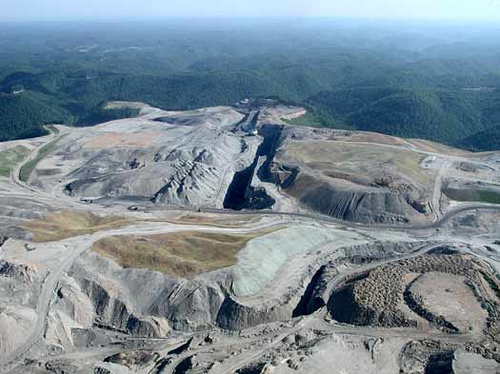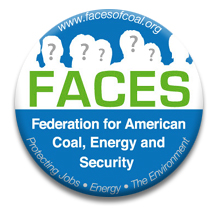It wasn’t enough for FACES — the bogus Big Coal front created by a Washington, D.C. lobby firm — to be pilloried on the Rachel Maddow Show and the Daily Show for using fake iStock photos in their ads.
Now comes Big Coal Gone Wild: The Sequel. While a broad and peaceful national movement rooted in the Appalachian coalfields has emerged to halt the destruction and death toll in the Appalachian coalfields from coal slurry-contaminated water, fly rock and mountaintop removal mining, FACES is running an incredibly bizarre ad that depicts the besieged coalfield residents as masked bandits:

Using Orwellian language, the ad not only violates FTC standards that “advertising claims must be truthful and they must be substantiated,” by erroneously accusing the EPA of “threatening more than 100,000 jobs” in the “thriving” Appalachian communities, it also extends a smear campaign that has inflamed violence against peaceful coalfield residents and anti-mountaintop removal protesters who are defending Appalachians against the assault of out-of-state Big Coal companies.
Who are the real FACES of the coalfield movement for a sustainable and diversified economy, clean energy jobs, and the preservation of the historic Appalachian communities?
Meet 81-year-old Roland Micklem, a Christian activist, who is organizing a Senior’s March to End Mountaintop Removal on Oct. 8, in Charleston, W.Va. Micklem and his octogenarian posse may lack the pecs of those in the bandit ad, but they bring the same resolve and fearlessness of Mary “Mother” Jones, the nonagenarian miner’s angel who marched on behalf of West Virginia coalfield residents in 1923. Micklem was recently arrested for a nonviolent blockade of the road to the Massey Energy regional headquarters in West Virginia.

Meet Mickey McCoy, an eastern Kentucky school teacher, who recently journeyed to Washington, D.C. to testify on the impact of mountaintop removal on his native Martin County, where a 300 million gallon toxic coal sludge spill wiped out the waterways and aquatic life for miles in 2000:
Mountaintop removal is an assault on the Appalachian Mountains, its people, their environment, and generations to come. It is not right for our government to allow the dismantlement of an entire culture for the sake of the greed of the coal corporations.
Here’s a great film on Mickey and his wife Nina’s journey from the coalfields to the nonviolent protest movement.
Meet Lorelei Scarbro, a coal’s miners widow and community organizer for the Coal River Wind Project, whose home, family cemetery, and mountain community are facing destruction from mountaintop removal:
Meet 95-year-old Ken Hechler, the legendary West Virginia congressman and secretary of state, and coal miners’ hero, who recently participated in several anti-mountaintop demonstrations.
In 1971, Hechler held his first hearing on mountaintop removal, and predicted the disastrous impact of strip mining on his region’s broader economy:
What about the jobs that will be lost if the strippers continue to ruin the tourist industry, wash away priceless topsoil, fill people’s yards with the black muck, which runs off from a strip mine, rip open the bellies of the hills and spill their guts in spoil-banks? This brutal and hideous contempt for valuable land is a far more serious threat to the economy than a few thousand jobs which are easily transferable into the construction industry, or to fill the sharp demand for workers in underground mines.
And meet Mat Louis-Rosenberg, a courageous young man who has dedicated his life to bringing clean water to the Prenter Hollow area in West Virginia, one of the most notorious cancer-ridden Clean Water Act-violated places in the nation, and to stopping mountaintop removal. On Oct. 15 in Boone County, West Virginia, Louis-Rosenberg will be the first person to appear before a jury trial, for his nonviolent protest at the Kayford Mountain mountaintop removal site (see below).

Prior to his trial, Louis-Rosenberg explained his nonviolent campaign:
I am writing you today to ask for your support. At dawn on May 23 of this year, myself and 7 others walked on to Patriot Coal’s Samples Mine on Kayford Mountain and locked ourselves to a gigantic rock truck used to haul away the rubble from blowing up a mountain. For the next four hours, we stopped that machine from continuing to participate in the destruction of Kayford Mountain. We were all arrested by the Boone Co. Sheriff’s Department and charged with trespassing and conspiracy to commit trespassing. My friend Glen Collins and I have chosen to fight these charges and be tried by jury on Oct. 15. The maximum jail sentence is 18 months. I am asking you to come to Madison, W.Va., and stand in solidarity with me and the communities across Appalachia being devastated by mountaintop removal.
Some folks have asked me why I have chosen to risk a jail sentence instead of simply taking the fine, and I’d like to say briefly why I think this is important. This campaign, just like the civil rights movement and many other struggles for change, is founded on a strategy of nonviolent civil disobedience. And just like the civil rights movement, it draws its strength and its power from the willingness of ordinary people to take extraordinary risks and sacrifices because of the strength of their beliefs. My conscience demands that I stand up in that court room and explain to the people of Boone Co. why I did what I did. I will not contest the facts of what happened, but rather assert my belief that what I did was right, that I was stopping a far greater crime than I was committing. And if I go to jail because of it, I know that I go as many have gone before me, in defense of my friends, this land and my convictions.
I have just been amazed at the support I have received from all the local people that I have worked with over this last year fighting for clean drinking water and healthy communities. They understand the importance of standing strong because for them this is a life and death issue. Everywhere I go, I meet people who’s homes have been ruined, who’s water has been poisoned, who have watched friends and family die around them, who had their land and heritage robbed from them for a lump of coal and a greasy buck. Kayford Mountain is the first place I ever came to in West Virginia. I spent three days working on Larry Gibson’s cabin up there and decided I wasn’t leaving. When I took that banner that read “NEVER AGAIN” up on that mine, I carried it for Larry. And Judy. And Bo. And Chuck. And Ed. And the people of Prenter. And that’s the message I’ll carry into that courtroom in Madison. I owe it to them.


